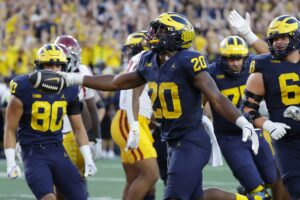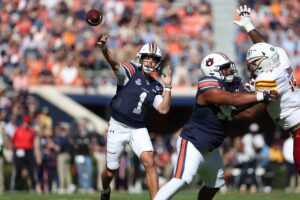We’ve seen coaches such as Nick Saban publically speak about it. It’s visible, particularly, during early 11:00 AM CST kickoffs. Comparatively, we can see as we look at the data that is right in front of us. College football has an issue that must be addressed. Attendance. There has been a steady decline in attendance for college football. Today, we look at the growing problem of college football attendance.
Announced Attendance vs Actual Attendance
In 2017, attendance numbers were down substantially over 2016 numbers. The Football Bowl Subdivision (FBS) saw its largest year over year drop in 35 years. In fact, the SEC, which is known for possibly the most fanatical fans in all of college football saw its attendance drop by just over 3%. Unfortunately, that doesn’t even tell the entire story.
The Wall Street Journal decided to go even a step further. They had a goal to look at the number of scanned tickets against the reported attendance. The results were fascinating. Only 71% of the reported announced attendance actually scanned their ticket to enter the stadium. Taking that into consideration, 2017 was the biggest drop in attendance in modern history. Some schools numbers were skewed at an alarming rate. For example, Louisiana Monroe reported a total attendance of 49,640 for their five home games in 2017. However, according to the wall street journal reporting, they only drew 13,302 fans in tickets scanned. That is just a 26% clip of the total attendance.
The Television Influence
The proposition of watching a game at home has become increasingly enticing for fans. No matter if you utilize cable television or you’ve made a decision to cut the cord, the opportunities are there. The television proposition is something that is becoming increasingly difficult for schools to battle against. First, looking at the ESPN family of networks there are five different networks that carry games through ESPN, ESPN2, ESPNU, SEC Network, and ABC. The same can be said for FOX and CBS which carry games on their main networks but also have the FOX Sports Network and FS1 as well as CBS with the CBS Sports Network. Let’s also not forget the Big Ten. PAC 12, and ACC networks as well.
Also, the smartphone technology has made it available to view games while you’re on the go. With the addition of Watch ESPN, ESPN3, ESPN+, FOX Sports Go, BTN2Go, PAC-12 Now, and the CBS Sports App makes a large majority of these games available as a mobile option. In fact, there are only six FBS games from Thursday until Saturday cannot be seen through the networks or apps listed above. In summary, 89% of the FBS college football slate can be viewed or streamed.
Betting on football is easy with BetQL. Check out BetQL for updated college football odds, lines, and spreads.
Cost Of Attendance
For some fans, nothing will keep them away from cheering on their favorite team. But, for a typical family, the cost of attendance can become quite substantial. There are multiple aspects that one must keep in perspective when considering the cost of attendance. On the outside looking in, initially, we just look at the ticket prices. However, part of that cost factor that should be considered is gas expenditure to and from the destination, any fee’s for parking, food and drink before/during/after the game, and of course the price for admittance into the game.
The price will certainly fluctuate based on the notoriety of the school, the game, and the location. For example, a game between Oklahoma and Texas versus a game between Oklahoma and Kansas State would be considerably different. For argument’s sake, let’s look at Oklahoma’s upcoming home game against Kansas State on October 26th for a family of four. When we assume a face value ticket of $60.00 per ticket, $20.00 in gas expenditures, $20.00 in parking, and $75.00 for food, drinks, and souvenirs it’s about a $350-$375 investment. And, you take into account that over a six-game home schedule the investment comes it around $2,000-$2,250. When you look at that proposition, some fans have a good alternative which causes the attendance numbers to fall.
Loss of Interest in the Product
Over the past few years, there’s been a considerable amount of discussion related to changing the game. Some believe the game is too long. And, there are constantly folks looking to improve the game. The belief from some is that one of the reasons for the lack of attendance is based on the product on the field is not what it used to be.
I’m not biting. Even if the product on the field is not at the same level, college football enthusiasts would still be there to support. Having said that, the product is as good as ever. We’ve been treated to fantastic games and atmospheres early on in the year. The Red River Rivalry as one of the best rivalries in college football was an excellent on-field product. The White-Out game between Ohio State and Penn State was an unbelievable atmosphere. The game is great. Don’t change a thing.
Non-Conference Schedules
There has been a fair amount of discussion around the schedules. The non-conference competition does play a significant role in the attendance problems. More specifically, when a blue-blood FBS team faces a low-level FBS team or even an FCS team that presents a problem. From a necessity perspective, the financial benefit that these teams receive from these game is pivotal to their athletic program.
Although it may be true that there has been some occasional upsets and close calls most of these contests are not competitive. The non-competitive nature is what causes the lowered attendance. A few games that come to mind where the home team can name the score are as follows: The Citadel vs Alabama, Furman vs Clemson, Savannah State vs Miami, Fl, Idaho vs Florida, Youngstown State vs West Virginia.
Conclusions
Now, it’s not fair to offer up a problem without considering any possible solutions. The television contracts and streaming applications will not change anytime soon. That’s a battle that the athletic administrations across the country will continue to battle against. And, with the technology such as 4K televisions coming to the forefront, it could get worse before it gets better.
The cost and scheduling move to the front of the line as potential opportunities for improvement. When an FCS team faces an FBS team, the product on the field is not what it needs to be. Perhaps, there could be additional discounts provided to students tickets as well as season ticket holders for those types of games. I know athletic programs are looking at all avenues to improve attendance. The growing problem of college football attendance is a real problem that needs to be addressed sooner rather than later to help protect the game that we all love.






